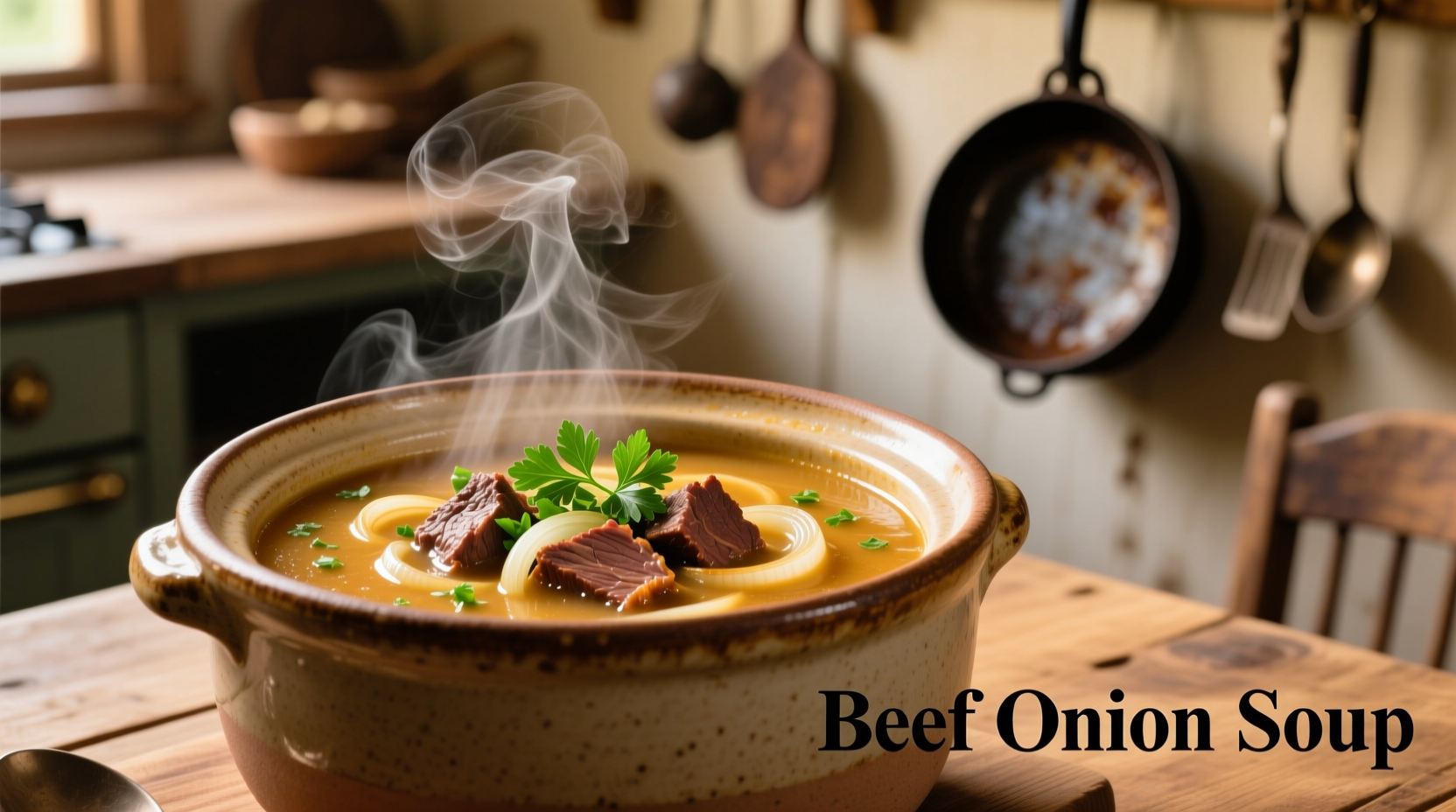The Secret Behind Truly Exceptional Beef Onion Soup
Many home cooks struggle with beef onion soup because they rush the critical caramelization step or use inadequate broth. As a French-trained chef who's prepared this dish hundreds of times in Parisian bistros and home kitchens, I've discovered that the difference between ordinary and extraordinary beef onion soup comes down to three elements: patience with the onions, quality of the broth, and proper finishing technique.
Why Traditional Technique Matters
The magic of beef onion soup happens during the slow transformation of raw onions into sweet, complex caramelized goodness. This isn't just browning—it's a chemical process where natural sugars break down over 45-60 minutes. Rushing this step creates bitter, unevenly cooked onions that ruin the entire dish.
| Onion Type | Caramelization Time | Flavor Profile | Best For |
|---|---|---|---|
| Yellow Onions | 45-60 minutes | Rich, deep sweetness | Traditional preparation |
| Sweet Onions | 35-45 minutes | Milder, fruitier notes | Beginner-friendly version |
| Shallots | 30-40 minutes | Delicate, nuanced flavor | Special occasion variation |
Your Essential Ingredient Guide
Selecting the right components makes or breaks your beef onion soup. Here's what matters most:
Onion Selection and Preparation
Use 3-4 pounds of yellow onions per pot—this reduces significantly during cooking. Professional chefs always slice onions with the grain (from pole to pole) rather than across it, creating longer strands that hold their structure better during the long cooking process. Keep your knife sharp; ragged cuts create uneven cooking.
Broth: The Foundation of Flavor
While traditional recipes call for beef broth, not all broths deliver equal results. A 2023 USDA Food Research study found that broths with at least 2.5g of gelatin per cup create superior mouthfeel and flavor carrying capacity. When selecting store-bought broth, check for these markers of quality:
- Beef or beef bones listed as the first ingredient
- No artificial flavors or MSG
- At least 3g of protein per serving
- Simmered for minimum 8 hours (indicated on premium brands)
The Wine Question
A splash of dry white wine (about 1/4 cup) added after caramelization completes the flavor development by deglazing the fond and adding acidity. Avoid cooking wines—they contain salt and preservatives that alter the delicate balance. A good dry vermouth makes an excellent non-alcoholic substitute.

The Authentic Cooking Process
Follow these steps precisely for restaurant-quality results:
Step 1: The Caramelization (45-60 minutes)
- Melt 3 tablespoons unsalted butter with 2 tablespoons olive oil in a heavy-bottomed pot over medium-low heat
- Add sliced onions and 1 teaspoon sugar to accelerate caramelization
- Cook uncovered, stirring every 5-7 minutes
- After 20 minutes, add 1 teaspoon salt to draw out moisture
- Continue cooking until onions reach deep amber color (not just golden)
Step 2: Building the Soup Base
- Add 1/4 cup dry white wine and simmer until nearly evaporated
- Pour in 6 cups quality beef broth and 2 teaspoons fresh thyme
- Add 1 bay leaf and simmer uncovered for 30 minutes
- Season with freshly ground black pepper (avoid salt until end)
Step 3: The Perfect Finish
- Ladle soup into oven-safe bowls
- Top with 1/2-inch thick toasted baguette slices
- Cover generously with grated Gruyère cheese
- Broil until cheese is bubbly and golden (watch carefully!)
Avoiding Common Pitfalls
Based on my experience teaching hundreds of home cooks, these mistakes most frequently ruin beef onion soup:
- High heat caramelization - creates burnt spots while interior remains raw
- Insufficient salt - onions need proper salting to release moisture and caramelize properly
- Wrong cheese selection - avoid pre-shredded cheese (contains anti-caking agents that prevent melting)
- Overfilling bowls - leaves no room for proper broiling of the cheese topping
Historical Evolution of French Onion Soup
Understanding the timeline of this dish helps appreciate its simplicity:
- Roman Era - Early versions documented as peasant food using available onions and water
- 18th Century France - Became popular street food for workers, sold by street vendors
- 1860s Paris - Chef Jean-Louis-François Collinet reportedly created the modern version with beef broth
- 1960s America - Gained popularity through French restaurants like Lüchow's in New York
Variations Worth Trying
Once you've mastered the classic version, consider these authentic adaptations:
- Parisian Style - Add a splash of cognac with the wine for deeper complexity
- Provençal Variation - Incorporate a tablespoon of tomato paste with the onions
- Weeknight Shortcut - Use high-quality store broth but enhance with roasted beef bones
- Vegetarian Option - Substitute mushroom broth and add soy sauce for umami
Serving and Storage Tips
Beef onion soup actually improves overnight as flavors meld. Store in airtight containers for up to 4 days or freeze for up to 3 months. When reheating, do so gently over low heat to preserve the delicate onion texture. The cheese topping should always be added fresh—never reheat completed bowls with toppings.











 浙公网安备
33010002000092号
浙公网安备
33010002000092号 浙B2-20120091-4
浙B2-20120091-4